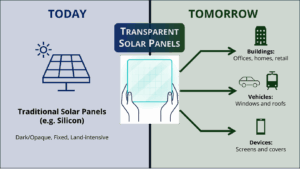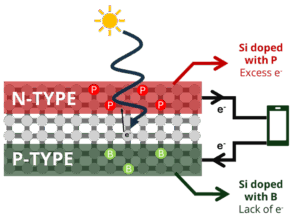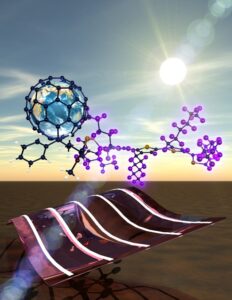Written by Josh Swindell
In school, we are taught that solar panels are part of a net-zero future that is not dependant on fossil fuels. The image most of us have in our heads is fields with row and rows of dark blue panels in a faraway dessert or sunny country. What if we could add solar panels into buildings everywhere and generate power without you noticing?

All solar panels (or photovoltaics/PVs) work by transforming light directly into usable electricity. Traditional solar cells are usually made of layers of silicon, with some atoms swapped with more or less electrons. The top layer, or ‘N-Type’, contain atoms with more electrons than silicon (e.g. phosphorus (P)). This layer is said to be electron ‘rich’, with excess electrons, so is slightly negatively charged. The bottom layer, or ‘P-type’, contains atoms with less electrons than silicon (e.g. Boron (B)). This layer is said to lack electrons so is slightly positively charged.
When light hits the solar cell with the right wavelength, it knocks an electron off a silicon atom. This electron can move towards the N-type layer and can then be pushed around an electrical circuit to generate power (i.e. charge a smartphone!).
See this video to find out more about how solar cells work.

However, silicon solar panels are opaque, require a lot of land and are expensive to install!
While more efficient, smaller solar panels are currently being developed, researchers are also working on semi-transparent panels. Next-generation solar panels absorb light that is not visible to the human eye (i.e. UV or IR wavelengths) and are incredibly thin (much thinner than a human hair!). These ultra-thin solar cell coatings can be adapted for windows in buildings, cars and even one day mobile phone screens without fundamentally needing to change how they are made!

This is made possible by replacing silicon, with organic-based based solar cells using carbon-based molecules which are lightweight, flexible (yes, they can even BEND) and inexpensive. Whilst they are not as efficient as silicon at generating electricity, they are improving rapidly and can be placed almost anywhere!
Companies such as Ubiquitous energy (see link below) are starting to commercialise this technology, with there being a real possibility of designing new greener buildings. Beyond buildings, imagine being able to charge your phone in an emergency or charge your electric car by leaving it in the sun!
The future of solar does look bright but can only be developed with the help of the creative next-generation material scientists!
To find out more about how solar energy and material science are revolutionising our transition to clean energy, watch the video linked below from one of our ambassadors, Lizzie.